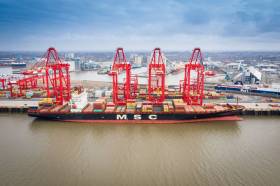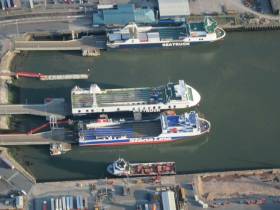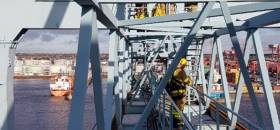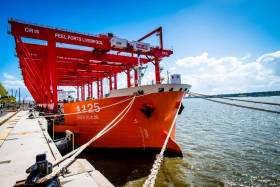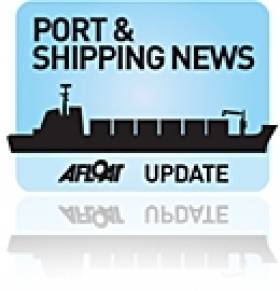Displaying items by tag: Peel Ports Group
#ports - A German stakeholder of a major UK ports group is considering selling its part of the business.
As the UK newspaper The Times reports, Deutsche Bank is considering selling part of its stake in Peel Ports Group, Britain’s second-biggest port operator, in a deal that could value the company at £4bn.
DWS, the German bank’s asset management arm, is understood to be mulling the sale of a 10%-15% stake in Peel Ports, which runs the Port of Liverpool.
DWS has owned 49% of Peel since 2006. It bought the share from property tycoon John Whittaker in a deal that at the time valued the business at about £1.6bn.
Peel handles more than 60m tons of cargo a year and about 13% of Britain’s maritime traffic, putting it second behind Associated British Ports (ABP), the biggest port operator.
It has spent hundreds of millions of pounds upgrading Liverpool with another deep-sea container terminal, Liverpool2.
For more click here.
Afloat adds Peel Ports other port run and related facilities are located in Dublin, Clydeport, Great Yarmouth, Heysham, London (Medway) and the Manchester ship canal.
#ports - A UK ports operator the Peel Ports Group has received the ‘Freight & Logistics’ category prize at the prestigious Mersey Maritime Industry Awards held in Liverpool.
Over 400 guests attended the annual event last Thursday where accolades were handed out to the best of the maritime industry from the Liverpool City Region and across the UK.
2018 was a year of significant milestones for Peel Ports, especially its container division in Liverpool, including a first direct call from China, its biggest container ship to date, a new rail freight service and a double-digit growth.
Accepting the award in Liverpool on behalf of Peel Ports, Chief Operating Officer, Patrick Walters said: “We are leading the way in bringing enhanced resilience and efficiency to the supply chain. By offering a viable, and in many ways more efficient, alternative to southern ports, the Port of Liverpool is supporting much needed change in the freight and logistics sector that will ultimately reduce costs, road miles and carbon emissions.”
The company has also secured a new 2M permanent transatlantic container service, the Canadian Express service connecting southern European Ports with Liverpool and ultimately Canada, as well as continued growth with key customers and national retailers such as B&M. Peel Ports is set to bring 250 new staff on board during 2019 in anticipation of new commercial opportunities.
For further information on Mersey Maritime, click here.
In addition to UK ports, Afloat adds the group also operates the MTL Terminal in Dublin Port with connections to the UK, the Netherlands, France, Iberia and onwards worldwide. The container terminal which has an annual throughput of 170,000 TEU is located on the South Bank Quay adjacent to the Poolbeg Y&BC in Ringsend.
Irish Sea Port Wins Project of the Year Award
#ferry -The Irish Sea port of Heysham on the UK west coast has won the Project of the Year Award.
The Award which was announced at the Peel Ports Group annual conference, reflected the work managed by the port teams across the UK network over the past year.
Costing £10m was the Heysham Capital Projects, which as the winner was recognised as a stand-out project at the conference awards. Mark Patterson accepted the award after being nominated by Stephen Mackenzie, head of projects for Peel Ports Group.
Three parts were involved in the project at Heysham Harbour that saw both new and upgraded facilities installed at the Lancashire port. The primary project was to install a new linkspan as Afloat previously reported for ports customers that serve Belfast, Douglas, Dublin and Warrenpoint
The infrastructure is to provide an improved service to existing customers, as well as bringing new capabilities for growing business at the port.
#FerryNews - A first for P&O Ferrymasters as the logistics supplies-chain operator opened a warehouse facility in the UK located in the Port of Liverpool.
According to MultiModal, P&O Ferrymasters has further expanded its supply chain network by opening the 800 square metre warehouse in Liverpool docks ferryport. Afloat adds the English north-west is part of the Peel Ports Group (see report on rival UK ports group, ABP).
The warehouse support its customers with cross-docking operations and feed its connection with P&O Ferries’ Liverpool-Dublin sailings which Afloat adds is served by a trio of ferries. They are ropax sisters, Norbank and Norbay and the larger passenger orientated European Endeavour. The company is a division of P&O Ferries, which sails on eight major routes between Ireland and the UK, Belgium, France and the Netherlands.
The warehouse - which will be open 24 hours a day and comprise eight loading bays supporting trailer and container operations - will give the logistics company an increased capacity to handle the projected uplift in daily full and part-load shipments across the Irish Sea. It will also support daily groupage and cross-docking operations, where loads from more than one customer are consolidated.
Andy Apsley, P&O Ferrymasters’ General Manager Ireland, said:“Following feedback from our customer base, we are introducing a cross-docking facility at Liverpool Port which will enable all customers to benefit from our portside location, streamline their logistical requirements and ultimately reduce their costs. Industry-leading IT systems such as load and cost optimisation and track and trace visibility will further enhance the customer experience.
“We manage more than 800 trailer movements a week into and out of the United Kingdom and our unique value proposition is being able to offer our customers – who come from all sectors including retail, fast moving consumer goods, automotive, and horticulture – a seamless, reliable and punctual service between Ireland, Britain and continental Europe.”
P&O Ferrymasters is a pan-European provider of logistics solutions. The company serves 20 strategic locations in 12 countries across the continent, operating integrated road, rail and sea links via a fleet of 4,000 trailers and containers. They also owns a rail terminal in the Romanian city of Oradea, which facilitates the onward movement of goods to Britain from Asian countries via the Silk Road.
Scaling New Heights As Dublin Fire Brigade Practice Exercises from Port Container Cranes
#DublinPort - In recent weeks Dublin firefighters scaled 110ft high container gantry cranes in Dublin Port so to play out real life situations as part of an ongoing height training programme.
Firefighters and paramedics from Dublin Fire Brigade were invited to the port by terminal operator Peel Ports, where they were given the chance to practice for worst case scenarios at height.
The cranes are used to load and unload container ships calling at the port and bound for locations in the UK, the Netherlands, France, Iberia and onwards worldwide. Up to 170,000 TEU pass through Peel Ports’ MTL container terminal each year, carrying a variety of goods and materials.
Firefighters recreated a situation whereby a crane driver had suffered a heart attack while in the cab. From the arrival of the height rescue team, they had scaled the crane, treated the driver and safely brought them to ground level within 28 minutes. This scenario also had an advanced paramedic treat the casualty from the top until they were lowered.
In a second drill, a maintenance engineer suffering spinal injuries was stabilised and brought to ground level while being treated by paramedics within 40 minutes.
The visit was also used by Peel Ports to strengthen and test its own health and safety procedures.
John Robinson, an officer and heights rescue instructor at Dublin Fire Brigade, said “It’s a great opportunity to train with the cranes here in the port. This allows us to build our training around a real life scenario that our fire crews could get called to and makes it interesting for them. I’d like to thank Peel Ports for allowing us to train on their facilities and we look forward to building this relationship further in the future.”
Stephen O’Gara, Operations Manager from Peel Ports, said: “We would like to offer our thanks to Dublin Fire Brigade for accepting our invitation to train using our facilities at the port. Working closely with our emergency services and preparing for the worst case scenarios ahead of time is incredibly beneficial for everyone involved and could be crucial when it comes to resolving a potentially life threatening situation. Health and safety is absolutely crucial to everything we do at Peel Ports, with our central aim that each member of staff returns home safely every day. We look forward to welcoming the fire crew back to the port at a future date and continue developing this important relationship”
For more information on Safety365 click HERE
Construction of Chinese Built 'Ireland' Max Containerships to Enter Service in 2018
#IrelandMax - Containerships currently under construction in China of the 'Ireland' Max class for BG Freight Line, a subsidiary of the Peel Ports Group in the UK are due to enter service next year, writes Jehan Ashmore.
BG Diamond is the first of a quartet of named ships as identified by Afloat earlier this year that is to operate on their short-sea hub feeder services linking Ireland, the UK, Belgium and the Netherlands.
Newbuild BG Diamond will along with sisterships be hired under long-term charter to the Dutch owned subsidiary. The other sisterships each with a 1004TEU capacity are the BG Emerald, BG Sapphire and BG Jade which was only christened last month at the Zhoushan Changhong International Shipyard.
As previously reported a new weekly container service between Liverpool and Cork has begun and this marked the first time the two ports have been connected directly through lo-lo operations. At the end of the each week, the current containerships on this route also offer services between Belfast, Greenock and Liverpool.
At the time of the route's announcement the ships to operate the service were Thea II (see TV presenter Paxman's Boxboat) along with RMS Veritas. However, from 2018, BG Freight will take delivery of the 'Ireland' Max quartet containerships on the short-sea feeder services of the company’s Irish Sea hub operations.
Each newbuild of around 11,000 gross tonnage will have 'green' credentials and built to DNV GL standards and will be fitted with state-of-the-art features in order to comply with Emission Control Area (ECA) requirements. In addition to adhereing to BG Freight Line’s navigation and trading needs.
'Ireland' Max class containerships have been developed by BG Freight Line, in conjunction with designers CIMC ORIC and Arkon Shipping.
Basic specifications of the new 'Ireland' Max containerships:
Containers: 1004 TEU (alternative 488 units 45ft)
Deadweight: 13,250 tonnes (on 8.0m draft)
Length overall: 153m
Reefer plugs: 253
Service Speed: 16 knots
Exhaust cleaning by WET-scrubber
#GiantCranes – Giant Chinese constructed cantilever rail-mounted gantry (CRMG) cranes arrived by heavylift vessel to Peel Ports Liverpool2 new £300m deep-water container terminal over the May Bank Holiday, writes Jehan Ashmore.
The CRMG cranes, the first of six are to be installed at Liverpool2, the Merseyside quayriver facility (not Liverpool Docks) to berth considerably larger and deep draft containerships. Docking at the port development was heavylift vessel, Zhenhua 25 that set off with the cranes from Nantong,China on the 11,930nm/20,000km voyage to Liverpool.
The 40 day passage of Zhenhua 25, took a route via south-east Asia, India, the Arabian Peninsula and through the Suez Canal before finally completing the voyage to Liverpool last Sunday.
On the opposite side of the Irish Sea, the Peel Port Group are the operators of the Dublin Port container terminal, Marine Terminal Ltd. At the MTL terminal near Ringsend, one of the largest vessels ships to use the facility, Nicholas Delmas (capacity: 2,207 TEU's) departed yesterday.
The Chinese built Nicholas Delmas had arrived from Liverpool from where the new quayside CRMG cranes to be installed having been also constructed by a Chinese manufacturer, ZPMC. According to the Peel Ports Liverpool, ZPMC also supplied the five ship-to-shore cranes already on site at the entrance to the port.
This first batch of CRMG's are the first of 12 required for phase 1 of the terminal. Ultimately the site will have eight STS and 22 CRMG cranes as part of a £100m investment.
The cranes will be capable of performing an average of 20 moves per hour, with semi-automated control linked to the port’s new Navis N4 terminal operating system. They have a 40 tonne under-spreader capacity and a maximum container lift height above quay level of 21m under spreader (6+1 containers).
Liverpool2 is to have a phased opening, with marine trials due to begin shortly and other elements of the semi-automated terminal coming online throughout Q2 of 2016. The first phase of the new terminal will be fully operational in the autumn.
Runcorn Dock Breaks Cargo Record and Doubles 2014 Freight Volumes
#RuncornRecord – Manchester Ship Canal port of Runcorn Docks has smashed its monthly cargo record and doubled its freight handled over the past 12 months, writes the Liverppol Echo.
The developments follow a multi-million pound investment by owner Peel Ports.
In December, the facility dealt with 50,126 tonnes of cargo – its highest-ever monthly total.
The cumulative weight of the record shipment of cargo is equivalent to more than 31,420 Range Rover Evoques, 122m tins of beans.
In addition to the port handling more than 66.8m boxes of Kellogg's Cornflakes carried on Coastal Deniz as featured in a TV documentary 'Ade to Sea' during a regular shuttle service to Liverpool Docks.
In the same month, Runcorn also handled its biggest ever single shipment of cargo in its history, with the arrival of vessel Kristin C, which discharged 6,212 tonnes of soda ash for its customer Newport Industries.
The ash will be used to manufacture glass. For more on this story, click HERE.
Afloat.ie adds that during the era of the last Guinness stout-tankers, they used to call to Runcorn Docks to discharge the black stuff for the UK market.
The Irish connection continues to the present day in the form of Arklow Shipping, whose distinctive green hull coloured general cargoships call, among them Arklow Viking.
According to Ships Monthly, the 1999 built vessel in November called to Runcorn Salt Works to load 4,000 tonnes of salt for Figueria de Foz in Portugal.
Peel Ports Group Strengthens Irish Investment with IEA Membership
#Ports - Peel Ports Group, one of the UK and Ireland’s largest port groups, expressed its support for a growing Irish export market by becoming a member of the Irish Exporters Association (IEA), a group widely regarded as the voice of Ireland’s export industry.
Peel Ports currently operates at Belfast (Victoria Terminal) and Dublin (Marine Terminals Limited) handling 30% of all containers entering the island of Ireland. Between them the terminals handle around 300,000 units of TEU every year.
Membership to the IEA will not only open up access to a wide community of exporters and service providers in the Irish market, but will also allow Peel Ports to further develop its comprehensive range of transport connections across its Irish Sea network.
In addition it will allow Peel Ports' customers to grow global trade and increase exports from Ireland by providing access to a vital part of the supply chain infrastructure and bring added value to supply chains in terms of efficiency and cost effectiveness.
With strategic port locations in Liverpool, Manchester, Dublin, Belfast and Glasgow, Peel Ports provides what it describes as a 'unique Irish Sea Hub', further supported by its shipping line BG Freight Line.
Furthermore, it says, the hub allows shipping lines to reduce the cost of repositioning empty containers by rebalancing equipment across the network.
Some 82.5% of laden containers which arrive into the Irish Sea Hub also leave as laden containers, which are higher than the UK average of 54% - making transportation in and out of Ireland cheaper, according to Peel Ports.
Through a joined-up approach the Irish Sea Hub offers 'a one-stop solution' for container customers, allowing multiple port calls across the Irish Sea, reducing transportation costs to Ireland.
Peel Ports’ global connectivity will be further enhanced when its new £300 million Liverpool2 development opens for business at the Port of Liverpool in 2015.
Liverpool2 will be the UK’s most centrally located deep water container terminal, enabling direct services from around the world to call at Liverpool, making it a more efficient feeder hub for the Irish market.
Gerard Gaffney, head of container operations at Dublin and Belfast for Peel Ports Group, said: “We are an agile and progressive business and take a collaborative approach to working with our customers.
"We have tailored the services we offer across the Irish Sea hub to suit the market demand and are dedicated to service, consistency and growth.
“We look forward to working with the IEW in its worthwhile endeavours to support Irish exports in an improving economic climate, recognising the obvious benefits it will bring to Peel Ports Group and our customers.”
Meanwhile, IEA chief executive Simon McKeever said: “We are delighted to support Peel Ports Group and look forward to working with them as they continue to develop their activities across the Irish Sea.”
Peel Ports Group Insists Liverpool 2 Is On Time and Budget
#Liverpool2 – The Peel Ports group which operates the Port of Liverpool has dismissed claims of delays and budget overrun of the £300m Liverpool2 container terminal project is over budget and behind schedule.
The scheme is to expand the Royal Seaforth Container Terminal by creating a new river berth to handle some of the world's biggest container ships (i.e Maersk McKinney Moller of 13,500 TEU) at Liverpool 2 after the widening of the Panama Canal. The project should be completed and ready to accept vessels by the end of 2015.
But one worker at the site, who asked to remain anonymous, said recent bad weather had thrown the scheme into turmoil. He said costs had soared due to extra plant needed to replace storm- damaged equipment, and drilling problems after hitting rock beneath the seabed had caused delays.
For more on this development, the Liverpool Echo has a report.
Previously Afloat.ie featured the Maersk 'Banana-Boats' which make trans-Atlantic calls firstly to the Port of Cork and where plans for the Ringaskiddy Redevelopment Project were put on public display in February.
Maersk Norfolk is one of several container fleetmates that after calling to Cork continue to the DP World owned London Gateway, one of several new or expanding UK ports developments catering for ever-increasing sized containerships.


























